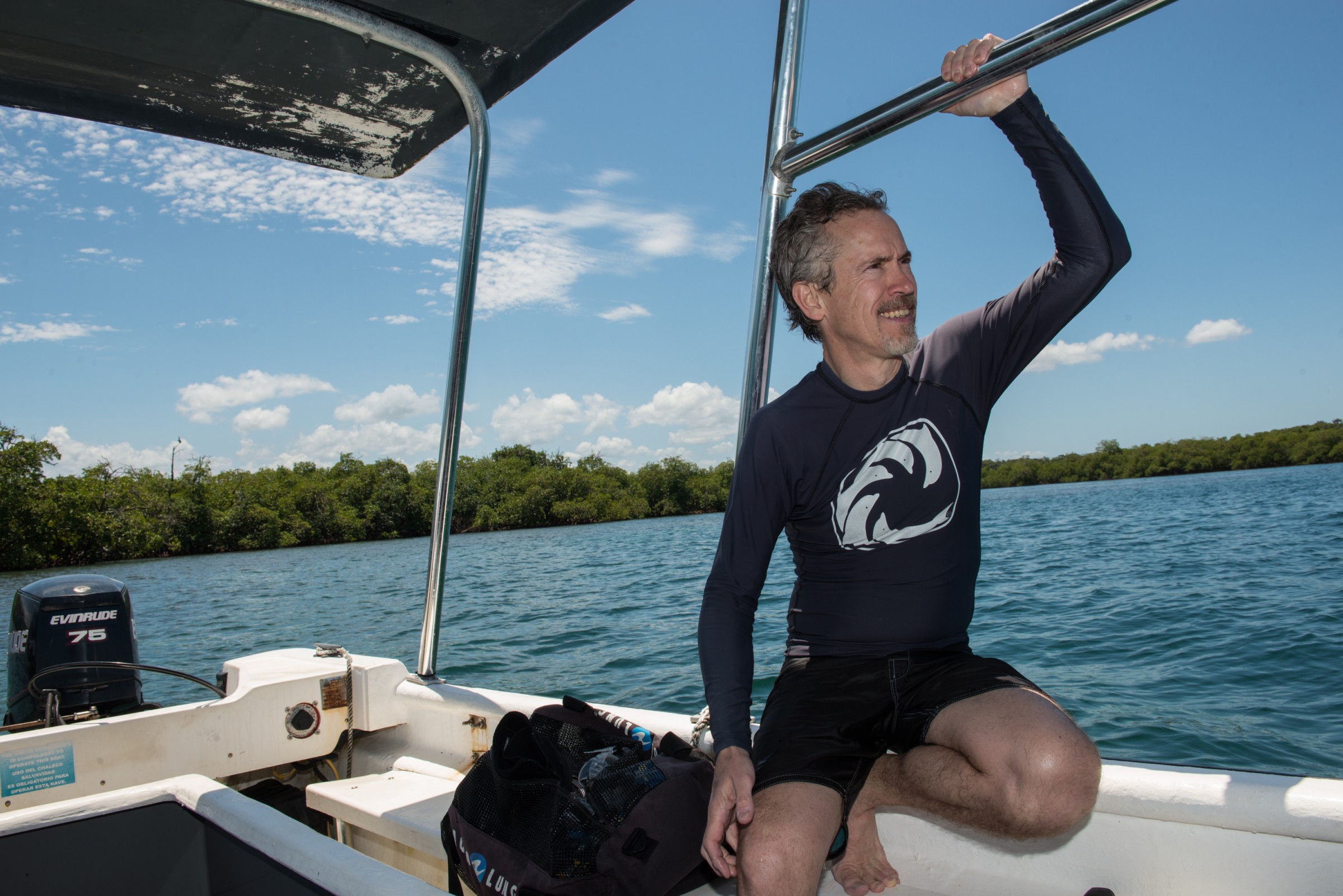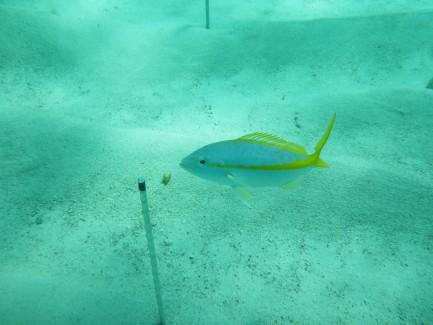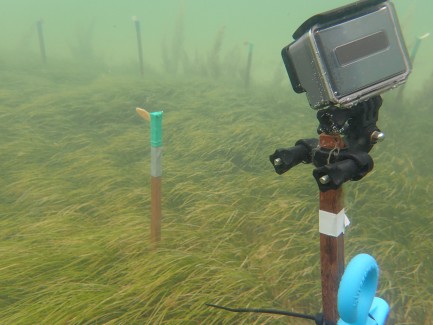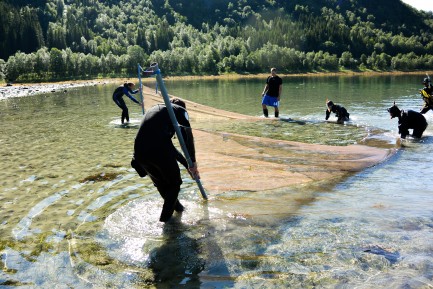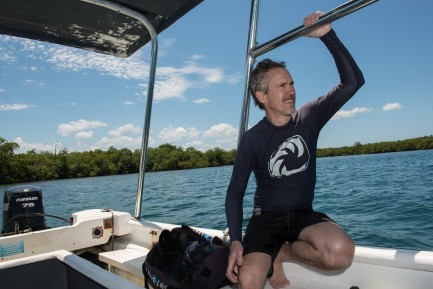A yellowtail fish approaches a “squid pop” in the coastal waters off Mexico. By planting squid pops (stakes with dried squid bait) in coastal waters around the world, ecologists were able to sketch a global “BiteMap” of fish feeding.
Global “BiteMap” Reveals How Marine Food Webs May Change With Climate
Where are small marine animals most vulnerable to getting eaten? The answer has big consequences for coastal ecosystems, where most of the world’s fishing takes place, since predators can radically change underwater communities. In a new study published in Proceedings of the National Academy of Sciences Oct. 26, an international team of scientists sketched the first global “BiteMap” showing where the ocean’s mid-sized predators are most active. By fishing with dried squid baits called “squid pops,” they discovered rising temperatures can shape entire communities of predators and have potential impacts lower down the food web.
“We know that communities around the world are changing with climate warming,” said Emmett Duffy, co-author on the paper and director of the Smithsonian’s Marine Global Earth Observatory program. But while warmer temperatures generally increase animal activities like eating, researchers are only just starting to grasp what those changes mean for marine ecosystems as a whole. “We might expect a soccer team, for example, to perform better in warm weather than in really cold conditions. But what if in the warmer conditions, the team switches out for different players? That can completely change the game.”
“Every biology textbook has a world map showing patterns in temperature, rainfall, nutrients or plant growth, but not predator feeding, even though we know that predation can be as important as these other things for understanding ecosystems,” said Jay Stachowicz, a co-author and professor of marine ecology at the University of California, Davis.
The new study was part of a project led by the Marine Global Earth Observatory (MarineGEO). Headquartered at the Smithsonian Environmental Research Center on the Chesapeake Bay, MarineGEO brings together partner researchers all over the world to understand what makes coastal ecosystems tick on a global scale. Duffy and his former technician, Ross Whippo (now at the University of Oregon), organized the project in 2016. Matt Whalen, a MarineGEO postdoctoral scholar at the Hakai Institute in British Columbia, Canada, and the paper’s lead author, analyzed the data that came out of the collaboration.
To map the appetites of coastal predators, scientists enticed fish and crabs with handmade treats called “squid pops.” Similar to the popular “cake pops” at coffee shops, a squid pop consists of a piece of dried squid meat attached to a stick.
“Most people think they’re lollipops, and I guess they could be for fish,” said co-author Jonathan Lefcheck, the coordinating scientist for MarineGEO at the Smithsonian Environmental Research Center.
Duffy invented the squid pops a few years ago when MarineGEO was first getting off the ground. He was searching for a standardized way researchers anywhere in the world could measure fish feeding and compare results.
“We basically looked at every kind of bait you can possibly buy in a tackle shop.…In the end we settled on this dried squid that we got from an Asian market in Hampton, Virginia, and that’s kind of the gold standard,” he said. Fish and crabs generally liked eating the squid in tests, and it is easy for scientists to buy and store it in dried form. “I will say it stinks,” Duffy added.
The team planted squid pops at each field site—which included seagrass beds and underwater mudflats—and returned the next day to see how many of the pops had gotten eaten. They also surveyed the types of fish and crabs present, using seine nets at 30 of the sites and video cameras at 14 of them.
In total, the map covered 42 underwater sites spanning five continents. They ranged from the southern tip of Australia to northern Norway just inside the Arctic Circle. Capturing the north-south range enabled the biologists to cover most of the global range in sea temperature. This, in turn, allowed them to explore how climate change could shape marine food webs in the future.
However, the results did not pan out as expected. The team thought they would see the highest predator activity near the equator, where temperatures are hottest.
“There’s this idea that when it’s hot, your metabolism ramps up, your body ramps up and you just need more food to keep your energy levels up,” Lefcheck said.
That rule of thumb generally holds true, the authors observed, and they saw the least feeding activity in the coldest waters in the poles. But they also discovered that predation peaked not near the equator but closer to the middle, in the subtropics.
Temperature played a role—but there was a twist. Although the squid pops disappeared faster in warm water, temperature also influenced the types of predators present at each site. Fish like porgies, half-beaks and grunts were among the most common animals caught on camera snacking on the squid pops. These fish were all but absent when scientists surveyed the hottest sites near the equator. In other words, warm waters not only increased appetites but altered biodiversity.
“Our results came as a big surprise to me,” said lead author Whalen, who added that he expected environmental factors like temperature to be the biggest keys to explaining their findings. “We know that the species of fish and the food webs in which they are embedded change a lot as you move from place to place across the world's oceans, but we did not expect to see quite as strong of a signal of the specific types of fish.”
In fact, statistical analysis showed that temperature had a stronger influence on which animals were present at each site than on how much they were eating.
The MarineGEO team hopes to expand the “BiteMap” of marine predation to the rest of the world’s coasts. They are especially eager to figure out why subtropical shores see more feeding frenzies from these mid-sized fish and crabs. Whalen speculates that it may be because the subtropics are a transition zone, where warm-water and cool-water animals can collide. It could also be that at the equator, temperatures get so hot that animals’ metabolism declines rather than rises. Alternatively, closer to the equator, even larger predators could be gobbling up the fish and crabs that would otherwise feast on the squid pops.
“Predicting the effects of global warming requires understanding entire ecosystems and the diversity of life within them, not just the direct effect of increased temperature,” Stachowicz said. “This should also serve as a reminder that other changes that affect predator communities, such as fishing and habitat alteration, can have dramatic effects on marine ecosystems.”
After publication, the study will be available at https://www.pnas.org/cgi/doi/10.1073/pnas.2005255117. An advance copy of the paper is available on EurekaAlert. For images or to speak with the authors, contact Kristen Minogue at minoguek@si.edu or (314) 605-4315.
# # #

